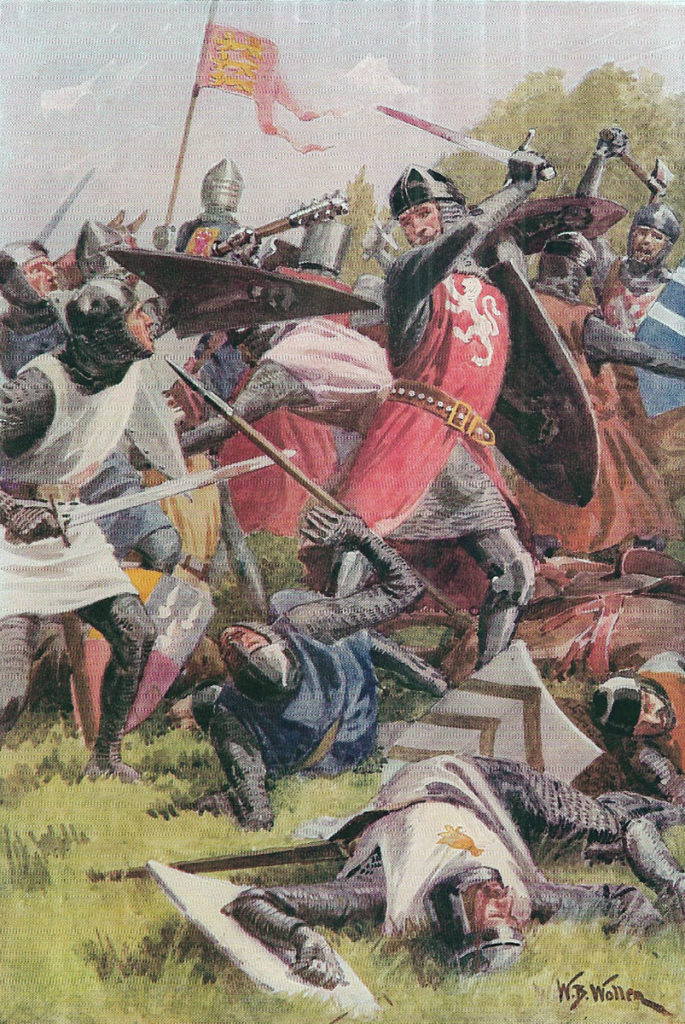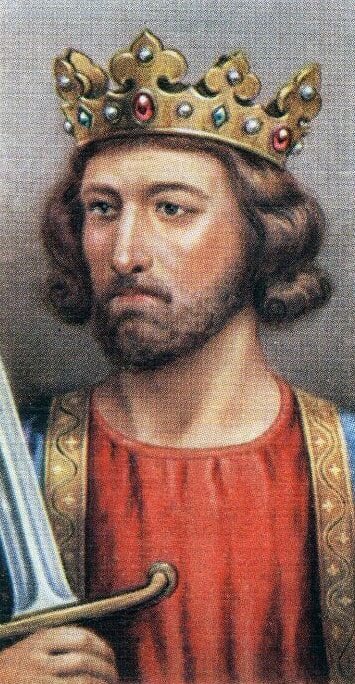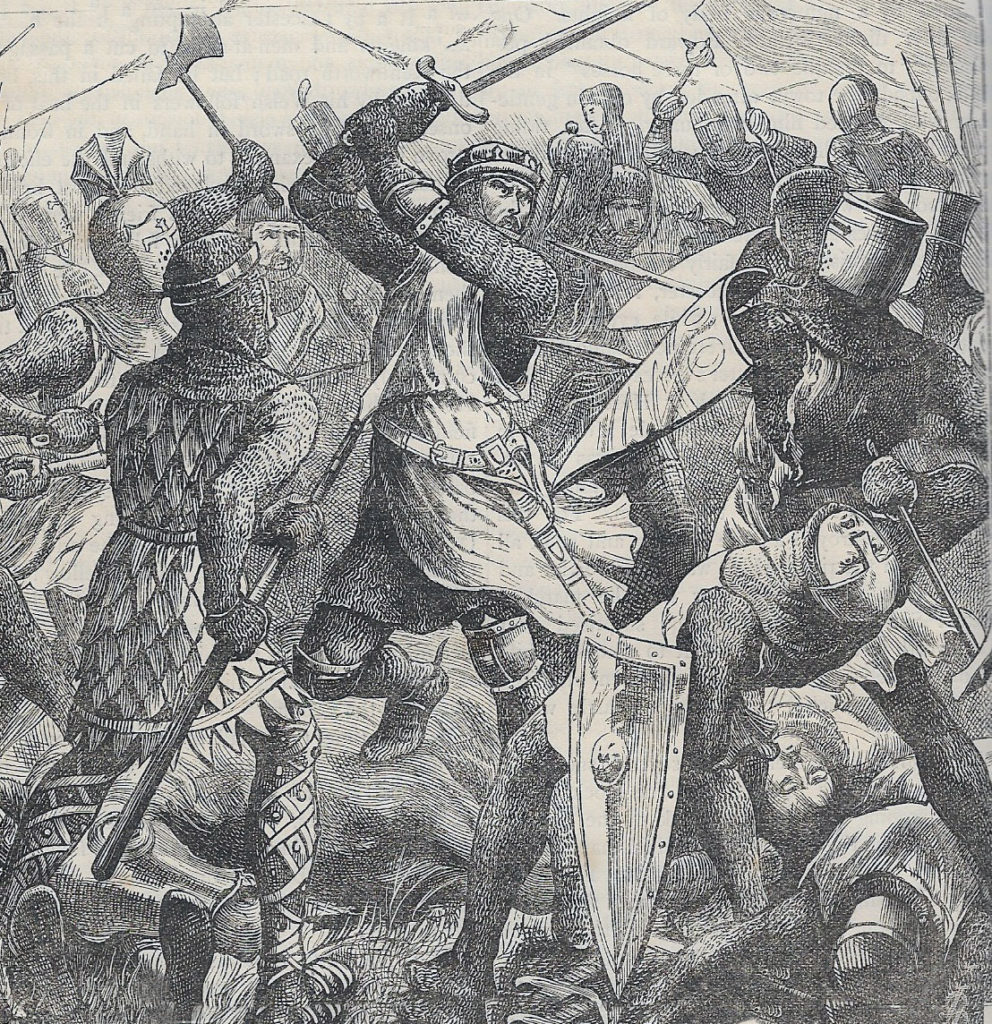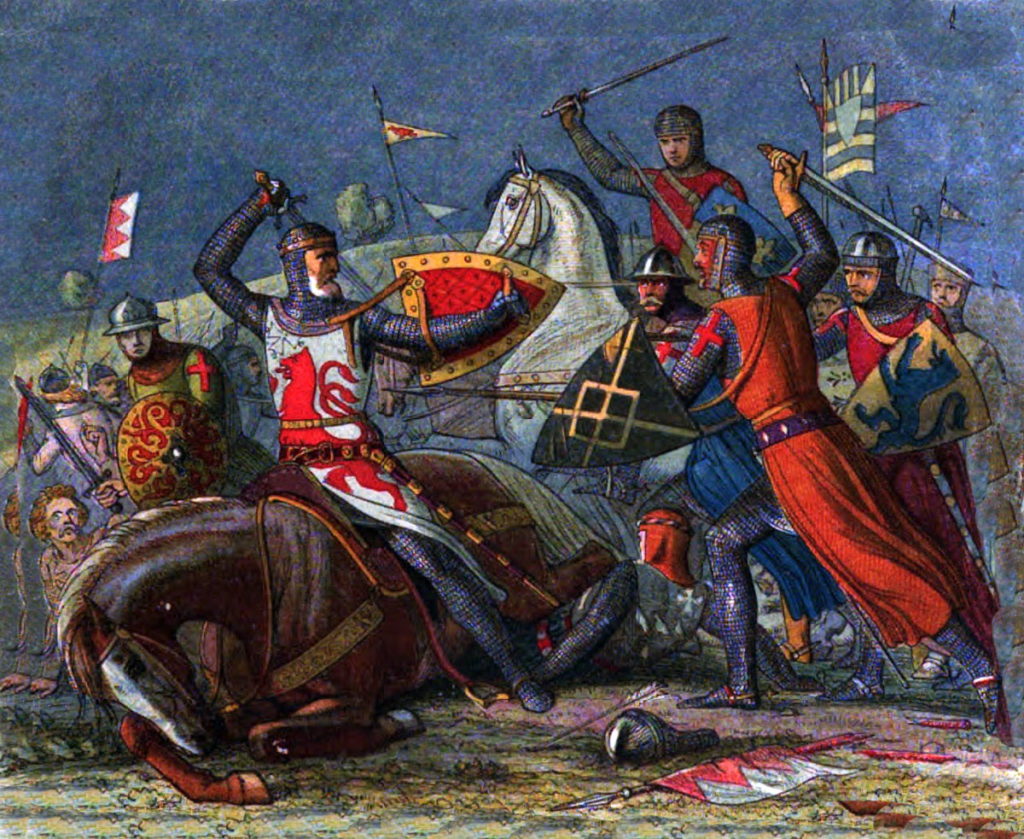The battle on 4th August 1265 seeing the defeat and death of Simon de Montfort in the Second Barons’ War
The previous battle in the Second Barons’ War is the Battle of Lewes
The next battle in the British Battles series is the Battle of Stirling Bridge
War: Second Barons’ War.
Date of the Battle of Evesham: 4th August 1265
Place of the Battle of Evesham: In Worcestershire in the West of England
Combatants at the Battle of Evesham: The army of the rebellious barons against the royal army.
Commanders at the Battle of Evesham: Simon de Montfort, Earl of Leicester against Prince Edward, King Henry III’s eldest son.
Size of the armies at the Battle of Evesham: Simon de Montfort led into battle 25 barons, 200 knights and some 6,000 foot soldiers, comprising 1,000 English and 5,000 Welsh.
Prince Edward’s royal army probably numbered around 10,000 knights and foot soldiers.
Uniforms, arms and equipment at the Battle of Evesham: Each army comprised a mounted contingent of knights, squires and men-at-arms and infantry who were either archers armed with the long bow or ordinary soldiers carrying spears, clubs, swords or any other weapon available to them.
At this time armour worn by those able to afford it comprised chain mail suits with steel helmets and shoulder and knee pieces.
A few of the infantrymen were armed with crossbows.
Winner of the Battle of Evesham: The royal army led by Prince Edward overwhelmed the barons’ army, releasing King Henry III from his captivity and bringing the Second Barons’ War towards its close. Simon de Montfort and many of the leaders of the barons’ revolt were killed.
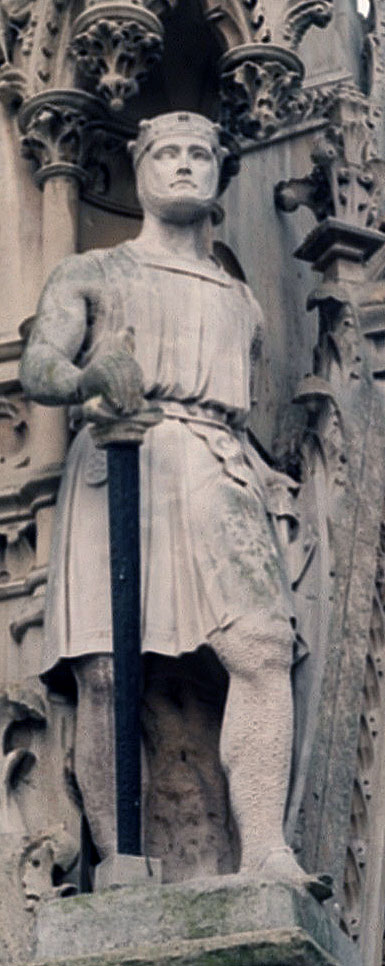
Events leading to the Battle of Evesham:
Following the Battle of Lewes Simon de Montfort and the rebel barons held King Henry III and his son Prince Edward in captivity. Although nominally permitting the king to continue in government de Montfort was for a time the de facto ruler of England.
In the spring of 1265, de Montfort moved to Hereford intending to overawe those marcher barons on the Welsh border who were inclined to support the king.
De Montfort took the king and Prince Edward with him, effectively as his captives.
On 28th May 1265 Prince Edward escaped from his escort at Hereford while exercising horses and rode to join the king’s supporter Roger Mortimore at Wigmore Castle in Herefordshire.
Prince Edward raised the royal standard and was soon joined by several of the marcher lords including the Earl of Gloucester, William de Valence and John de Warenne.
The counties of Cheshire and Herefordshire declared for the king.
Prince Edward quickly secured all the crossing places over the River Severn, preventing de Montfort from crossing the river into central England the principal areas of his support.
De Montfort marched his army to Newport, where he expected ships from Bristol to transport his men over the Severn estuary.
These ships were sunk by a royal flotilla sent from Gloucester, leaving de Montfort’s army marooned in Wales.
De Montfort turned north and marched to Hereford, arriving at the end of July 1265.
In the meantime, de Montfort’s eldest son, also called Simon, had been raising his supporters across southern and central England, before advancing to Kenilworth, near Warwick.
Receiving information that the army led by the younger de Montfort had reached Kenilworth, Prince Edward marched out of Worcester and arrived at Kenilworth in the early hours of 1st August 1265.
De Montfort the younger’s army was taken by surprise and dispersed by Prince Edward’s men, many of the leading barons being killed or captured.
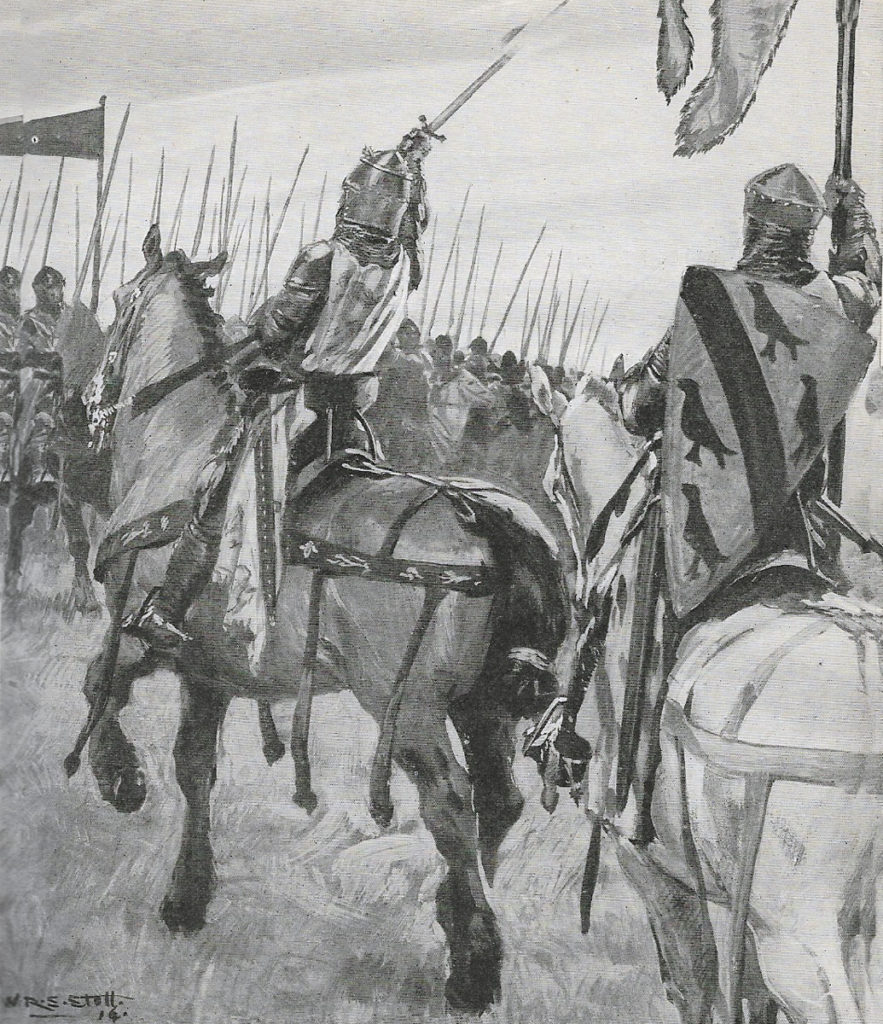
The royal troops secured the banners of the principal rebel leaders and captured a complete supply train that had just arrived for the rebel troops in Kenilworth
Simon de Montfort himself escaped into Kenilworth Castle, where he and a few others were beyond Prince Edward’s reach.
Prince Edward’s army returned promptly to Worcester with its prisoners.
While Prince Edward’s army was marching to Kenilworth and returning to Worcester, de Montfort, realising the royal piquets were no longer in place guarding the river crossings, crossed the River Severn at Kempsey, four miles south of Worcester, intent on joining the army assembled by his son at Kenilworth.
On 3rd August 1265 de Montfort’s army marched to Evesham.
De Montfort was unaware that that his son’s army had been surprised and dispersed by Prince Edward two days before.
On the evening of the same day, having arrived in Worcester to the news that de Montfort had crossed the River Severn and marched for Evesham, Prince Edward promptly set off and marched through the night to cut de Montfort’s route from Evesham to Kenilworth.
Having marched east to the River Avon near Dunnington, Prince Edward turned south towards Evesham.
The Earl of Gloucester was detached from the main army and marched parallel to the Prince to his west.
Mortimer marched on to the River Avon and continued down the east bank of the river to cross directly into Evesham from the south-east, in de Montfort’s rear.
De Montfort’s army would be surrounded by the three columns of the significantly stronger royal force.
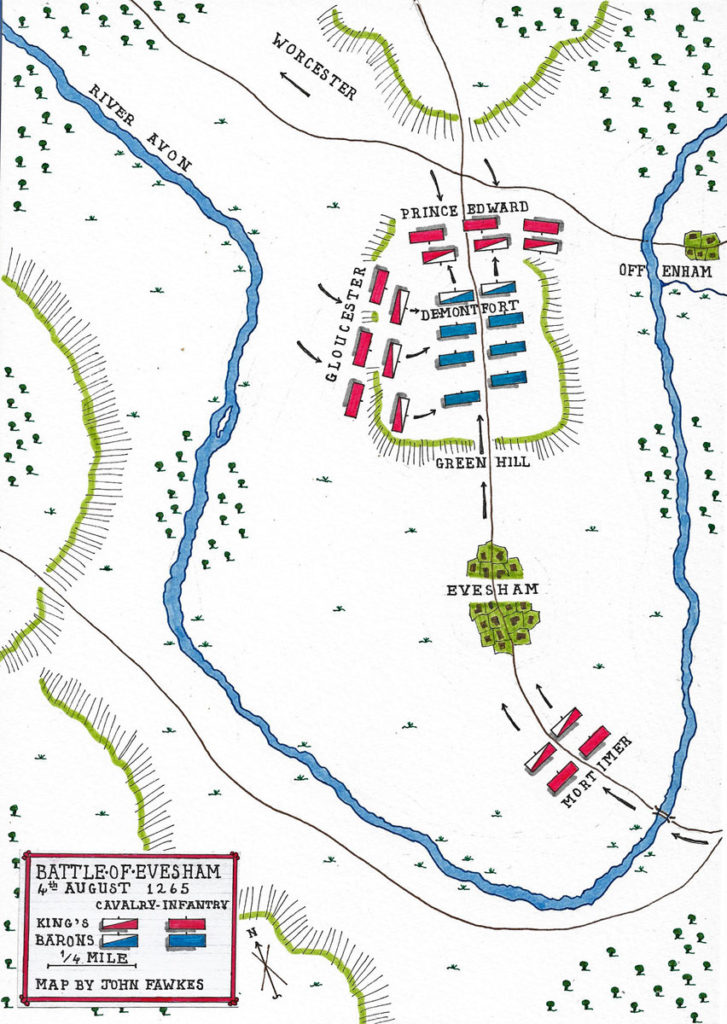
Account of the Battle of Evesham:
De Montfort awoke on the morning of 4th August 1265 to the news that a powerful force was advancing on Evesham from the north by the Dunington-Norton road, Prince Edward’s main section of the royal army.
De Montfort and his men turned out to observe the approaching troops, not immediately correctly identifying them.
De Montfort believed that he was observing his son’s army arriving from Kenilworth, particularly as the standards of several prominent rebel barons could be seen among the leading ranks, the white lion of Montfort, the silver star of de Vere and the three escutcheons of Montchensy.
With such a powerful reinforcement de Montfort anticipated inflicting an overwhelming defeat on Prince Edward’s royal army.
Quickly de Montfort was disabused. Further back in the column the royal standard came into view flying over the advancing troops.
Prince Edward had arranged for the captured banners to be displayed as a ‘ruse de guerre’.
A second column, Gloucester’s force, came into sight to the west of the first and marching parallel to it.
News reached de Montfort of the third royal force approaching Evesham from the south-east. He realised that his army was surrounded by an overwhelmingly stronger royal army and faced complete destruction.
De Montfort is reported as crying out ‘Now may God have mercy on our souls, for our bodies are in the power of our enemies.’
Henry de Montfort urged his father to flee the battlefield, but he rejected the idea, instead pressing Despenser, Basset and other rebel barons to save themselves, an offer they rejected.
De Montfort formed his men into a column and began to march up Green Hill towards the Prince’s advancing royal army.
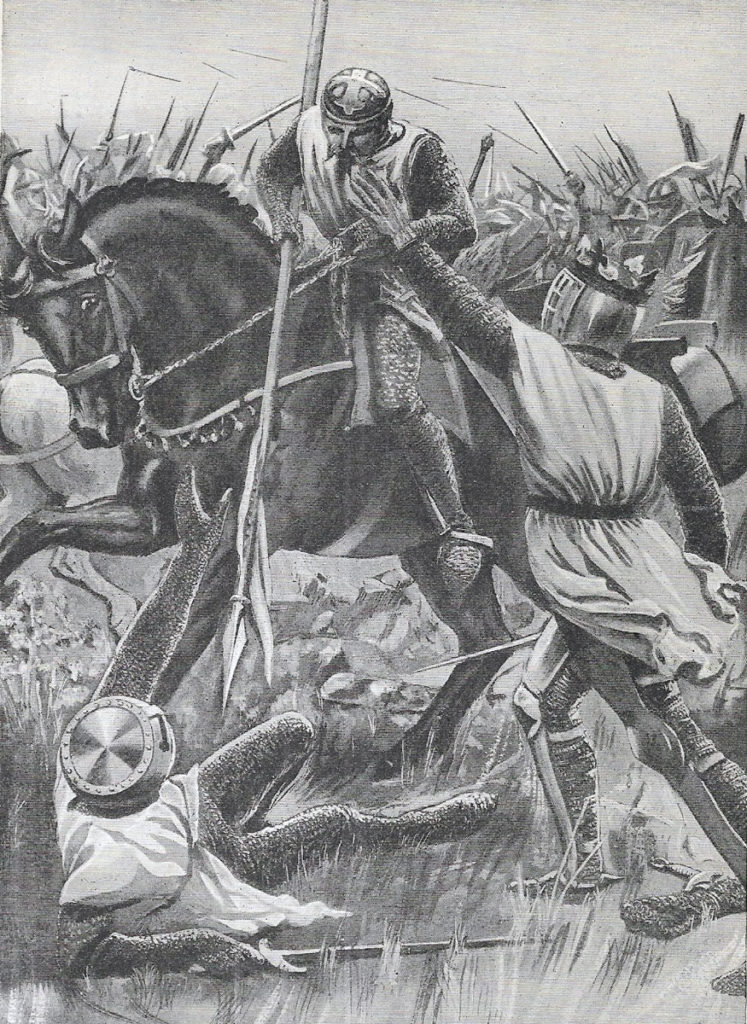
At the rear of de Montfort’s column the Welsh infantry began to slip away into the neighbouring houses and gardens, before swimming across the River Avon to escape.
De Montfort led an attack on the Prince’s army that was so desperate and determined that the royal army recoiled and had to be rallied by Warren of Bassingbourn, while Gloucester’s men came up and launched an assault on de Montfort’s flank and rear.
It is said that no quarter was asked for or given in the battle.
After an hour’s struggle Henry de Montfort fell mortally wounded and Simon de Montfort’s horse was killed under him.
Assailing his opponents on foot de Montfort was attacked by a number of knights eager for the honour of killing the rebel leader.
De Montfort fell dead surrounded by the bodies of his most devoted companions, Peter de Montfort, Despenser the Justiciar, Ralph Basset, John de Beauchamp, William de Mandeville, Guy Baliol, Robert de Tregoz and Roger de Rivle.
Others were wounded and became prisoners, Humphrey de Bohun, John Fitz-John, Henry of Hastings and Guy de Montfort, Simon’s third son.
The barons’ army was wiped out in what the chronicler Robert of Gloucester described as ‘murder not a battle’.
The escaping Welsh foot soldiers were hunted through Evesham and along the river banks and cut down.
Casualties at the Battle of Evesham:
A chronicle gives the casualties in the rebel army as 160 knights, 220 squires, 2,000 English foot soldiers and 5,000 Welsh foot soldiers killed, while the royal army lost only 2 knights, although nearly 2,000 royal foot soldiers were killed or wounded.
Follow-up to the Battle of Evesham:
The Second Barons’ War smouldered on until mid-1267 when the King and Prince Edward made peace with Earl Gilbert.
Simon the younger and Guy de Montfort left England.
Anecdotes and traditions from the Battle of Evesham:
- As De Montfort intended to fight his way out of Evesham and march to join the remnants of his son’s army he had the king with him, clad in armour, concealing his identity. Throughout the battle the king called out to the attacking royalist knights and foot soldiers ‘I am Henry of Winchester, your King. Do not harm me.’
References for the Battle of Evesham:
The Art of War in the Middle Ages Volume One by Sir Charles Oman
Battles in Britain 1066 – 1517 by William Seymour
British Battles by Grant.
The previous battle in the Second Barons’ War is the Battle of Lewes
The next battle in the British Battles series is the Battle of Stirling Bridge
